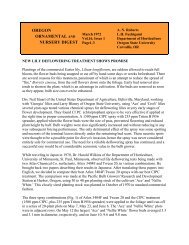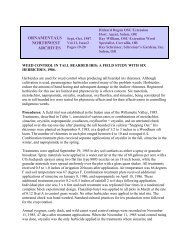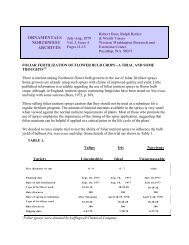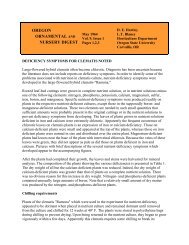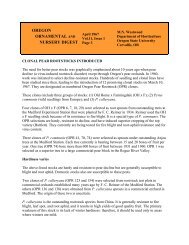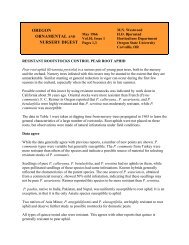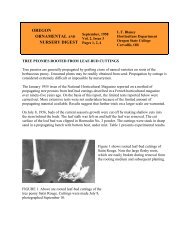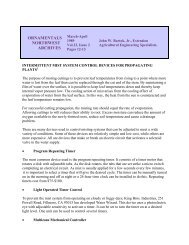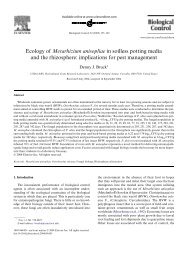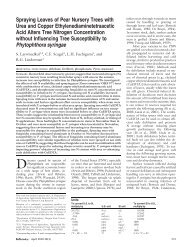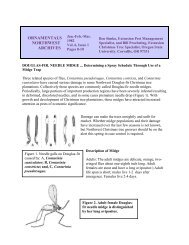Evaluation of a Metal Probe pH Meter - Department of Horticulture
Evaluation of a Metal Probe pH Meter - Department of Horticulture
Evaluation of a Metal Probe pH Meter - Department of Horticulture
You also want an ePaper? Increase the reach of your titles
YUMPU automatically turns print PDFs into web optimized ePapers that Google loves.
ORNAMENTALS<br />
NORTHWEST<br />
ARCHIVES<br />
Nov.-Dec. 1988<br />
Vol.12, Issue 6<br />
Pages 20-21<br />
David R. Hershey, <strong>Department</strong> <strong>of</strong><br />
<strong>Horticulture</strong>, University <strong>of</strong> Maryland,<br />
College Park, MD 20742-5611.<br />
EVALUATION OF A METAL PROBE <strong>pH</strong> METER 1<br />
<strong>Probe</strong> <strong>pH</strong> meters are marketed by many horticultural suppliers and cost from about $5 to $21. A<br />
probe <strong>pH</strong> meter consists <strong>of</strong> an analog meter attached to one or two metal probes. To measure <strong>pH</strong><br />
the probe(s) is pushed into moist growing medium, and the indicator needle points to the <strong>pH</strong>.<br />
Despite low cost and seemingly simple operation, probe <strong>pH</strong> meters have <strong>of</strong>ten been criticized as<br />
being unsuitable for horticultural use (1,3). The purpose <strong>of</strong> this study was to evaluate the<br />
accuracy <strong>of</strong> a probe <strong>pH</strong> meter for measuring growing media <strong>pH</strong>.<br />
A "<strong>pH</strong> Computer" probe.<strong>pH</strong> meter was purchased from two horticultural suppliers. The <strong>pH</strong><br />
Computer has two, 9 cm metal probes, a <strong>pH</strong> range <strong>of</strong> 3 to 10, a $21 cost, and is made by<br />
Environmental Concepts, 710 NW 57th St., Fort Lauderdale, FL 33309. The probe <strong>pH</strong> meters<br />
were compared with a research-grade, glass electrode <strong>pH</strong> meter (Orion 720) to measure <strong>pH</strong> <strong>of</strong><br />
sphagnum peat moss, previously incubated for 8 weeks with 0 to 6 g CaCO3/liter, and <strong>pH</strong> buffer<br />
solutions <strong>of</strong> <strong>pH</strong> 4.0, 7.0 and 10.0. Saturated medium samples or buffer solutions were placed in<br />
25 x 100 mm plastic test tubes into which the probes were inserted to their full depth. There were<br />
five measurements for each medium or buffer sample for each <strong>of</strong> the two meters.<br />
Table 1. Average <strong>pH</strong> <strong>of</strong> sphagnum peat moss 'SPM) measured with probe (<strong>pH</strong>) Computer<br />
and glass electrode (Orion) <strong>pH</strong> meters.<br />
Sample<br />
Manufacturer's directions were followed for<br />
each instrument. The Orion 720 was<br />
Sample<br />
calibrated using a two-point standardization<br />
CaCO3 Orion "<strong>pH</strong> Computer"'<br />
(g /liter)<br />
with <strong>pH</strong> 4.0 and 7.0 buffers. The <strong>pH</strong><br />
A B<br />
Computer could not be standardized, but<br />
SPM 0 3 6 4.8 5.4<br />
was calibrated by the manufacturer. Prior to<br />
each measurement the <strong>pH</strong> Computer probes<br />
SPM 1 1.5 4.5 5.0 5.2 were wet with deionized water and polished<br />
SPM 3.0 5.6 6.6 6.7 briskly with the paper toweling that came<br />
with the meter.<br />
SPM 4.5 6.3 6.5 6.8<br />
SPM 6.0 6.7 6.9 6.9<br />
The directions were not specific regarding<br />
the polishing procedure so the probes were<br />
<strong>pH</strong> 4 - 4.0 10.0 1 0.0 "polished briskly" by rubbing the probes<br />
<strong>pH</strong> 7 - 7.0 8.8 5.5<br />
five times from base to tip. The probes were<br />
then inserted in the sample to their full<br />
<strong>pH</strong> 10 - 10.1 8.5 8.1
depth, and the <strong>pH</strong> reading made one minute after insertion as directed.<br />
<strong>Probe</strong> <strong>pH</strong> meters appear to be too inaccurate for<br />
horticultural use.<br />
The probe <strong>pH</strong> meter readings generally did not agree closely with the glass electrode meter<br />
readings (Table 1), but gave similar readings to each other. The probe <strong>pH</strong> meters overestimated<br />
<strong>pH</strong> <strong>of</strong> unlimed sphagnum peat moss by 1.2 or 1.8 <strong>pH</strong> units, making them too inaccurate for<br />
horticultural use. Measurement <strong>of</strong> the <strong>pH</strong> buffer solutions with the probe meters was less<br />
accurate than the growing medium measurements. The <strong>pH</strong> 4.0 buffer gave a <strong>pH</strong> reading that was<br />
<strong>of</strong>f-scale (above 10) on both <strong>pH</strong> Computers. The <strong>pH</strong> 7.0 buffer gave a reading <strong>of</strong> 8.8 on one <strong>of</strong><br />
the <strong>pH</strong> Computers and a reading <strong>of</strong> 5.5 on the other. <strong>Probe</strong> <strong>pH</strong> meters supposedly work by<br />
measuring "slight variations in the electrical current arising from changes in the acid content <strong>of</strong><br />
the soil" (Personal communication, AMI Medical Electronics). However, <strong>pH</strong> is not a measure <strong>of</strong><br />
electrical current but <strong>of</strong> hydrogen ion activity; this may explain the low accuracy <strong>of</strong> the probe<br />
meter.<br />
This research supports the opinions (1,3) that probe <strong>pH</strong> meters are unsuitable for horticultural<br />
use. Interestingly, the <strong>pH</strong> Computer directions state that it was "tested for accuracy at a State<br />
Dept. <strong>of</strong> Agriculture Station", but does not state the degree <strong>of</strong> accuracy found. Because probe <strong>pH</strong><br />
meters appear to be too inaccurate, the least expensive <strong>pH</strong> meter suitable for horticultural use is<br />
the pocket-size, digital type (2) costing about $32.<br />
References<br />
1. Handreck, K.A. and N.D. Black, 1984. Growing media for ornamental plants and turf. New<br />
South Wales Univ. Press, Kensington, NSW, Australia. p. 365.<br />
2. Hershey, D.R. 1988. An inexpensive, pocket-size meter for measuring growing media <strong>pH</strong>.<br />
HortScience 23:404.<br />
3. Swain, RB. 1985. The basics <strong>of</strong> soil acidity. <strong>Horticulture</strong> 63(5):10-12.<br />
1 From: Nurserymen's News, Summer 1988<br />
Pesticide Use - Due to constantly changing laws and regulations, no liability for the suggested use <strong>of</strong> chemicals in<br />
this Newsletter is assumed by the ONW Newsletter. Pesticides should be applied according to label directions on the<br />
pesticide container.<br />
Permission to Reprint material appearing in the ONW Newsletter is granted with the request that you credit the<br />
source: Ornamentals Northwest Newsletter, date, volume, issue, page numbers. Do not excerpt or reprint in such a<br />
manner as to imply the author's endorsement or criticism <strong>of</strong> a product or concept.<br />
Nondiscrimination - The information in the Ornamentals Northwest Newsletter is provided with the understanding<br />
that no discrimination is intended and that listing <strong>of</strong> commercial products implies no endorsement by the authors.<br />
Criticism <strong>of</strong> products or equipment is neither intended nor implied.





